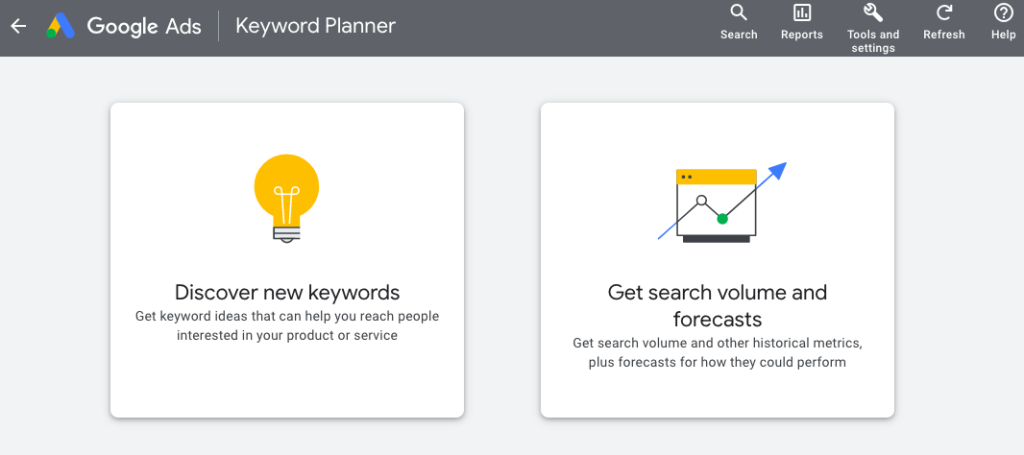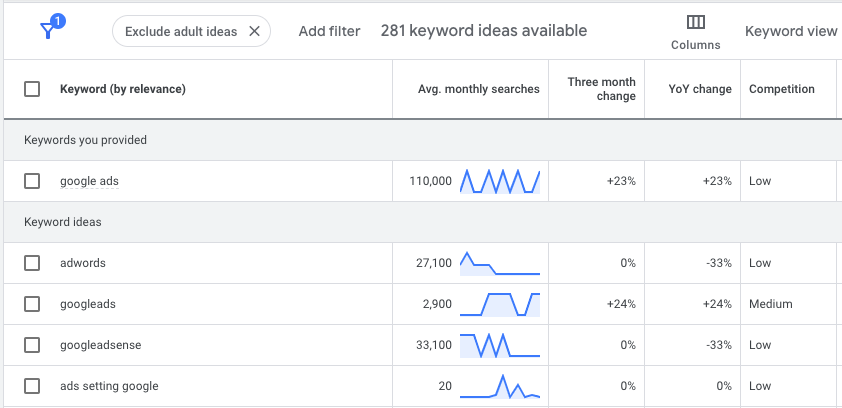If you are an SEO specialist looking to optimize your website or if you want to make sure that your content is keyword-rich and relevant, then this blog post is for you! We have created a comprehensive checklist that covers all of the key aspects of keyword research, from planning and research to implementation. Read on for more information.
Some important points should be considered and not skipped while doing keyword research. These are the following:
- Search your main keyword in the search bar
- Know your audience
- Find a primary keyword to target
- Analyze your audience to identify their needs
- List your keywords and find your main keyword
- Identify long-tail keywords
- Check search intent
- Analyze your competitors’ strategies
- Check the volume and difficulty of your keywords
- Optimize your content
Following a regular keyword checklist will also positively affect the performance of campaigns created in Google Ads. Conducting extensive keyword research for advertising campaigns, following the bid adjustments of these keywords regularly after creating the campaign, and similarly conducting regular negative keyword checks will allow the ads to be shown to the relevant target audience and thus improve the quality score of the ad.
Let’s a little bit dive into these checklist points in PPC marketing.
Search Your Main Keyword in the Search Bar
Searching your main keyword in the search bar is an important part of the keyword research process. To start this process, enter your primary keyword into the Google search bar and look at what appears in the SERPs. Make sure to write down the keywords that appear as they are often related to the topic of your website or business. You can also use forums to help you get ideas for keywords related to your topic. Once you have a list of keywords, you can use them to find your main keyword and identify long-tail keywords that are relevant to your business. This will help you understand how users are searching for information related to your business.
Of course, only this method is not used. With the Google Keyword Planner, which can be accessed by advertisers and SEO experts who want to do keyword research in the Google Ads Manager interface, you can see the monthly search volumes of the keywords, the bid strategy given by the competitors, and other alternatively searched keywords. In this way, you can know how often and how keywords are searched on the Google SERPs, in the language and location targeting you have determined, and in what results they get on average. There are other paid or free keyword-checking websites where you can do this.
Know Your Audience
It is essential to understand your target audience before you can begin your keyword research. Knowing who your target audience is, their needs, and what they care about will help you create a more effective keyword strategy. Researching your target customers and understanding their interests, behaviors, and preferences will help you identify the keywords that will be most effective in reaching them. You can use surveys, interviews, online tools, social media analytics, and other methods to understand your target audience and the language they use when searching for products or services like yours. Once you have a better understanding of your target customers, you can start to form an effective keyword strategy that reaches them.
Find a Primary Keyword to Target
After conducting keyword research and understanding the needs of your target audience, it is important to identify a primary keyword to target. The primary keyword should be related to the main topic you have chosen and should be specific enough that it can drive relevant traffic to your website. When selecting a primary keyword, you should consider its volume, difficulty, and search intent. It is also important to consider how it relates to other keywords you have identified. For example, if you find a primary keyword related to one of your long-tail keywords, you can use those related keywords in your content for optimization. By researching and analyzing different types of keywords in Google Ads, you can identify the best primary keyword for your website.
Analyze Your Audience to Identify Their Needs
Analyzing your audience is an essential step in the keyword research process. By understanding who your target audience is and what their needs are, you will be able to identify the terms and phrases that they are likely to use when searching for content related to your topic. This includes analyzing things like their demographics, interests, and intent. You can also look at the types of content they are drawn to and identify keywords that are associated with that content. For example, you may discover that your audience is interested in main topics related to health and wellness, so you can incorporate terms like “wellness”, “fitness”, “nutrition”, and “exercise” into your keyword list. Understanding the needs of your audience will help you to create content that resonates with them.
List Your Keywords and Find Your Main Keyword
After you have identified your audience and their needs, it is time to list the keywords that will help you target them. You should create a list of all the relevant keywords that can be used to reach your target audience. You should also create a list of long-tail keywords to complement the primary keyword. Once you have your list of keywords, you should analyze them to identify the main keyword that best suits your content. You should look at each keyword’s search volume and difficulty to determine which is the most suitable for your content. Additionally, you should analyze search intent to ensure that the keyword is appropriate for your web page.
Identify Long-Tail Keywords
Once you have found your primary keyword and identified your audience’s needs, the next step is to identify long-tail keywords. Long-tail keywords are specific search terms that are characterized by being three or more words long and are usually more unique than two-word phrases. Using keywords tools, “Phrase Match Report” can help identify these keywords. Additionally, you should also check the search intent of the keywords to ensure that you are targeting the right audience with the right content. Once you have identified your long-tail keywords, it is important to analyze the volume and difficulty of each keyword to determine which ones will be most effective for your content optimization strategy.
Check Search Intent
Once you have identified your primary and secondary keywords, it’s important to determine the search intent behind them. Search intent is essentially the reason why someone would type in a certain keyword. It can be categorized as either informational, navigational, transactional, or commercial. Knowing the intent behind each keyword will help you optimize your content accordingly. For example, if someone types in “buy e-commerce books” they are likely looking to purchase something. On the other hand, if someone searches for “what is e-commerce” they may be looking for information and not necessarily looking to purchase anything at the moment. Understanding search intent is essential for creating content that answers user queries and leads to conversions such as CPC, CTR, CPM, and other important KPIs.
Another important issue in the search volume of keywords by users is bid adjustments. Bid adjustments in Google Ads allow for an increase in click-through rates and ROI while allowing advertisers to customize their campaigns and increase their chances of success by adjusting bids based on factors such as location, device, time of day, past website visitors, competitors, and more. With bid adjustments decided based on performance data, the budget for an underperforming keyword can be reduced or replaced with an alternative recommendation based on search results. With regular KPIs dashboard monitoring, we can both measure the performance of our ad campaigns and save our budget by taking quick action.
Analyze Competitors’ Strategies
Once you have identified your main keyword, you can analyze the strategies used by your competitors to optimize their content. Analyzing your competitor’s keyword strategies can help you identify gaps in the market and come up with new ideas for content.
While researching your competitors’ strategies, you should look for the keywords they are targeting, the types of content they are producing, the quality of their content, and how often they are publishing. Additionally, you should look at the backlinks they have and track any changes in their search rankings over time. With Google Ads insights, you can observe your competitors and get more detailed information about their ad performance. By working on your competitors’ keyword strategies, you can gain insights into what’s working for them and use this information to develop a more effective plan for your own business.
On the other hand, with Search Term Report in Google Ads, you can reach the performance results of your search results and determine your action plan together with your campaign performance analysis.
Check the Volume and Difficulty of Your Keywords
Once you have identified your main keyword and generated a list of related ones, it’s time to check the search volume and difficulty of your keywords. This is an essential part of your keyword research checklist as it helps you determine which keywords will be most effective for driving traffic and conversions.
You can directly go to the Keyword Planner or other platforms which enable you to search volume of keywords and then easily check the average monthly searches of that keyword and possible ideas.
To find the search volume of each keyword, you can use tools such as Google Keyword Planner. It’s important to look for keywords with a high search volume and low difficulty rating. This will help you narrow down your list to the most relevant and valuable keywords for your business. Additionally, it’s important to check the competition for each keyword so that you can determine how difficult it will be to rank for them. Once you have identified the best keywords for your website, you can optimize your content accordingly and begin to see results from your SEO efforts.
Optimize Your Content
One of the most important points in Google Ads optimization is the organization of the content. The quality of the content you offer about your products and services on your website will also affect your ad quality. A qualified landing page will increase your ad clicks. Therefore, giving importance to content optimization will affect performance in all areas.
Once you’ve identified the keywords you want to target, it’s time to optimize your content for maximum SEO impact. Use the primary keyword in the headlines, body copy, and description of your web page. Make sure that it is used in a natural and relevant way that is easy for readers to understand. Additionally, include other related keywords throughout the content to help increase visibility in search results. Additionally, use images and videos to provide further context and help engage users. Finally, make sure that all of your content is optimized for both desktop and mobile devices so that you can reach a wider target audience. With these tips, you can ensure that your content is optimized for maximum search engine visibility.
Popular Posts
-
How Many Keywords Should Be In an Ad Group in Google Ads?
Ever wondered if your Google Ads campaigns are packed with…
Read more -
Google Ads Script for Dummies: An Introduction
Imagine you have an e-commerce website that sells licensed superhero…
Read more -
Google Ads Sitelink Character Limits
Your Google Ads are cutting off in the middle of…
Read more -
What Is Conversion Value in Google Ads?
What if you could put a price tag on every…
Read more
Register for our Free 14-day Trial now!
No credit card required, cancel anytime.







